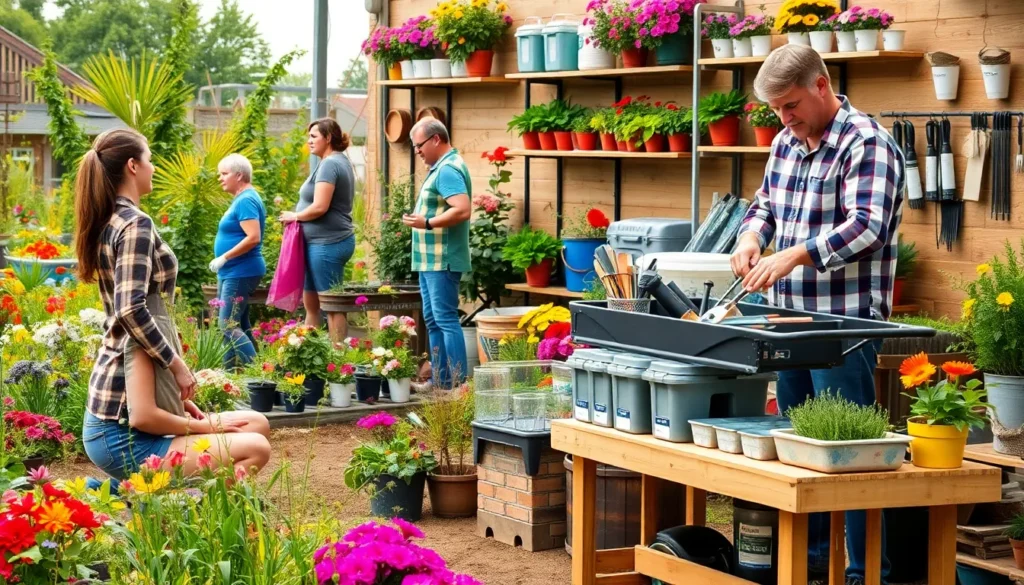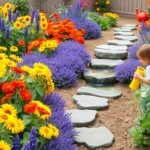We’ve all stood in our gardens feeling overwhelmed by the beautiful chaos around us. Whether you’re dealing with scattered tools or struggling to find space for new plants, an organized garden transforms both your growing experience and your outdoor sanctuary.
Smart garden organization isn’t just about aesthetics – it’s about creating efficient systems that save time and maximize your growing potential. From vertical storage answers that use every inch of space to strategic plant placement that enhances both beauty and functionality, the right organizational approach makes gardening more enjoyable and productive.
We’ll explore practical strategies that work for gardens of every size and budget. These proven organization ideas will help you create designated zones for tools, optimize plant spacing, and establish systems that keep your garden running smoothly throughout the growing season.
Create Dedicated Storage Zones for Garden Tools
Building on our organization foundation, we’ll now focus on creating strategic storage areas that transform chaotic tool collections into efficient workspaces. These zones eliminate the frustration of searching for misplaced equipment while keeping everything within easy reach.
Establish a Central Tool Station
Creating a central hub for your most frequently used tools saves countless steps during busy gardening days. We recommend positioning this station near your garden’s main entrance or in the area where you spend the most time working.
Select a sturdy workbench or repurpose an old table as your primary tool base. This surface should accommodate hand tools like trowels, pruners, and cultivators while providing space for potting activities. Add a pegboard backing to hang tools vertically, maximizing your storage capacity.
Install small containers or mason jars to hold seed packets, plant labels, and small hardware items like screws or ties. Label each container clearly to maintain organization throughout the growing season.
Position a water source nearby if possible, as many gardening tasks require quick tool cleaning. A simple bucket or small sink attachment makes this central station even more functional.
Install Wall-Mounted Tool Racks
Wall mounted systems use vertical space effectively while keeping long handled tools like rakes, shovels, and hoes safely stored. We’ve found that mounting racks at shoulder height prevents tools from falling and makes access effortless.
Choose adjustable rack systems that accommodate tools of varying lengths and handle thicknesses. These systems typically feature movable clips or hooks that secure each tool individually, preventing the domino effect when removing one item.
Install racks in covered areas such as sheds, garages, or under roof overhangs to protect tools from weather damage. Even a simple lean to structure can house these wall systems effectively.
Group similar tools together on your mounted racks for intuitive organization. Place all digging tools in one section, cutting tools in another, and maintenance equipment in a third area.
Use Rolling Cart Systems
Rolling carts bring tools directly to your work area, eliminating multiple trips back to storage locations. We particularly appreciate how these mobile stations adapt to different garden sections throughout the day.
Invest in weather resistant carts with multiple tiers to separate tools by function or project type. The top tier works well for frequently used hand tools, while lower shelves accommodate heavier items like watering cans or fertilizer containers.
Customize cart organization with small bins, tool clips, or magnetic strips attached to the sides. This customization keeps smaller items secure during transport while maximizing storage capacity.
Store carts in central locations when not in use, ensuring they’re easily accessible for your next gardening session. Many gardeners find that parking carts near their tool stations creates an efficient workflow between stationary and mobile storage options.
Design Efficient Potting and Work Areas
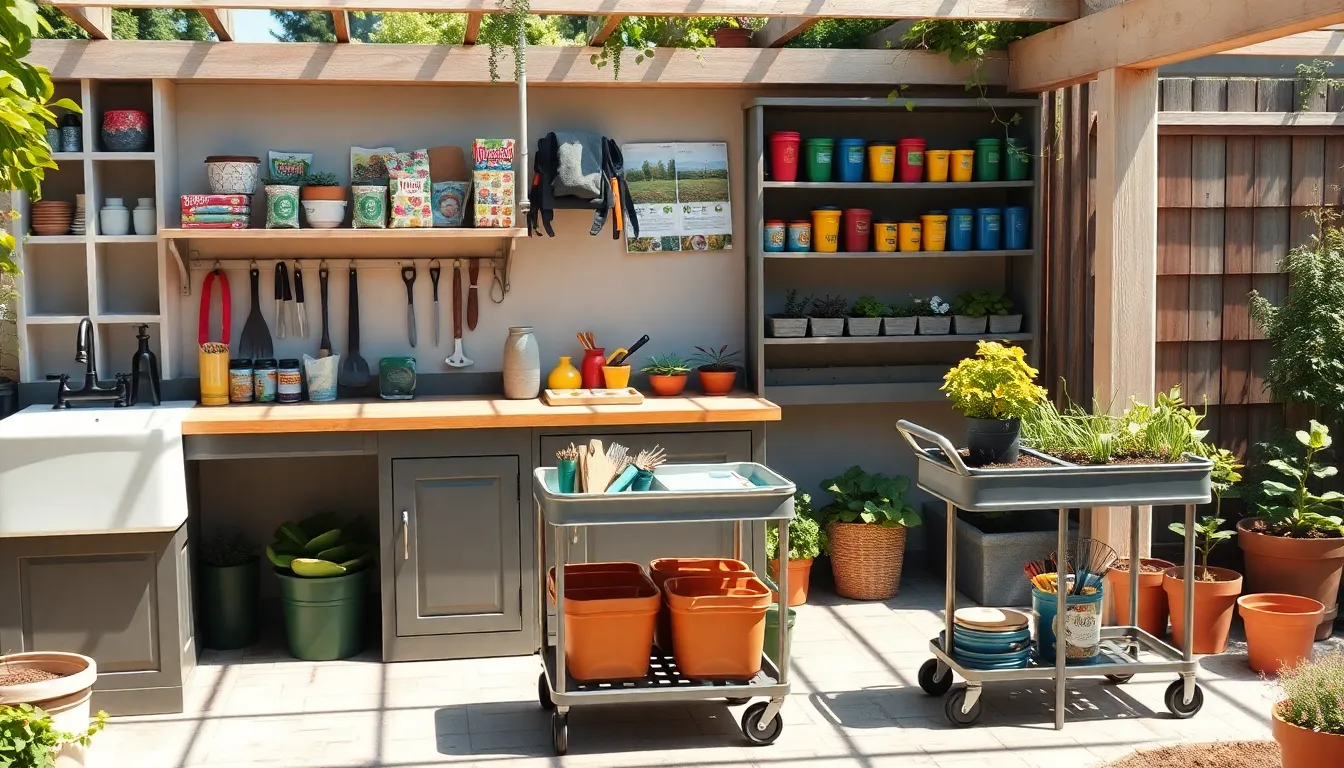
Beyond tool storage, we need dedicated spaces where the real magic of gardening happens. These work areas serve as command centers for our most important gardening tasks like transplanting seedlings and preparing containers.
Set Up a Functional Potting Bench
Creating a sturdy foundation starts with selecting a table that can handle heavy soil bags and constant moisture exposure. We recommend installing built-in storage drawers underneath the work surface to keep hand tools like trowels, pruning shears, and plant markers within arm’s reach.
Incorporating essential features transforms a basic table into a gardening powerhouse. Add hooks along the sides for hanging gloves and watering cans, while a built-in sink makes cleanup effortless after messy potting sessions.
Positioning the bench strategically near a water source eliminates the need to carry heavy watered containers across the garden. We suggest including a nearby waste bin to collect old soil and plant debris during repotting activities.
Organize Potting Supplies in Labeled Containers
Storing seeds and fertilizers in clearly labeled bins prevents costly mix-ups that can damage plants. We use transparent containers so we can quickly identify contents without opening multiple lids during busy planting seasons.
Maximizing vertical space with shelving systems keeps supplies organized while conserving floor area. Place heavier items like soil bags on bottom shelves for stability, while lighter materials such as seed packets fit perfectly on upper levels.
Grouping related materials streamlines our workflow by keeping potting soil near containers and fertilizers alongside watering supplies. This systematic approach reduces time spent searching for materials during critical planting windows.
Create Mobile Workstations
Building rolling cart systems allows us to transport supplies directly to garden beds without multiple trips back to storage areas. These mobile units can hold everything from hand tools to watering equipment in organized compartments.
Customizing carts for exact tasks maximizes their effectiveness throughout different seasons. We dedicate one cart to seed starting supplies while another focuses on harvesting tools and collection baskets.
Installing small storage units like repurposed mailboxes near frequently worked garden beds keeps essential tools handy for quick maintenance tasks. This approach eliminates the frustration of walking back to retrieve forgotten pruning shears or plant ties.
Implement Smart Seed and Plant Organization Systems
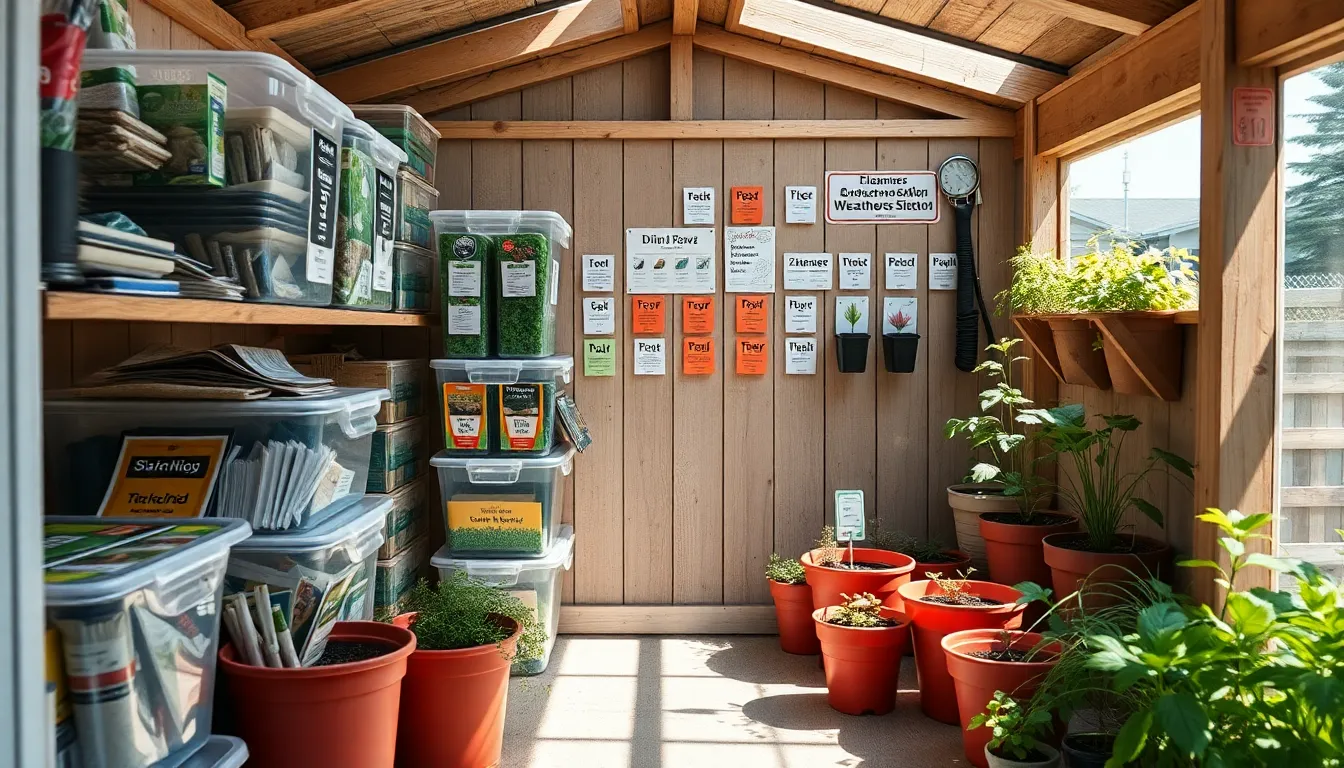
Effective garden organization extends beyond tools to cover the seeds and plants that form our garden’s foundation. Smart organization systems help us track seed viability, monitor planting schedules, and manage our growing inventory with precision.
Use Clear Storage Containers for Seeds
Clear storage containers revolutionize seed management by providing instant visibility into our collection. We can quickly identify seed types without opening multiple containers, saving valuable time during busy planting seasons. These transparent containers also help us monitor critical seed conditions like moisture levels, which directly impacts seed viability and germination success.
Stackable clear containers maximize storage efficiency in limited spaces like sheds or garages. We recommend grouping seeds by planting seasons or plant categories within these containers to create an intuitive system. Labeling each container with permanent markers or adhesive labels further improves our ability to locate exact seeds quickly.
Airtight clear containers protect seeds from humidity and pests while maintaining visibility. We’ve found that smaller containers work best for individual seed packets, while larger ones accommodate bulk seeds or multiple varieties of similar plants.
Create Plant Labels and Identification Systems
Systematic plant labeling eliminates guesswork and confusion in our gardens. We should include essential information on each label: plant names, planting dates, and exact care requirements. This approach helps us track growth progress and maintain consistent care routines throughout the growing season.
Weather-resistant materials like laminated tags or engraved stakes ensure our labels survive outdoor conditions. We’ve discovered that plastic stakes with permanent markers work well for temporary labeling, while metal or ceramic tags provide long-term durability for perennial plants.
Color-coded labeling systems streamline garden management by creating visual cues for different plant categories. We can assign exact colors to plant types (vegetables, herbs, flowers) or care requirements (high water, low water, full sun). This system allows us to identify plant needs at a peek and optimize our maintenance routines.
Digital tools complement physical labels by creating comprehensive plant databases. We can use garden journal apps or spreadsheets to record detailed planting information, expected germination times, and growth milestones for future reference.
Organize Plants by Growth Requirements
Grouping plants according to their growth needs optimizes resource allocation and promotes healthier gardens. We should cluster sun-loving plants in areas with full exposure while positioning shade-tolerant species in naturally shaded locations. This strategic placement reduces plant stress and minimizes our maintenance efforts.
Water requirement groupings create more efficient irrigation systems. We can establish zones for high-water plants near irrigation sources and place drought-tolerant varieties in areas with natural drainage. This organization reduces water waste and ensures each plant receives appropriate moisture levels.
Soil preference clustering improves growing conditions and simplifies soil amendments. We group acid-loving plants like blueberries together, allowing us to treat entire sections with exact soil amendments rather than individual plants. Similarly, organizing plants by nutrient requirements helps us apply fertilizers more efficiently.
Growth cycle organization aids in planning garden activities and maximizing output. We separate annuals from perennials to streamline replanting schedules and group plants by harvest times to optimize succession planting. This systematic approach ensures consistent harvests and reduces garden maintenance throughout the growing season.
Establish Irrigation and Watering Organization
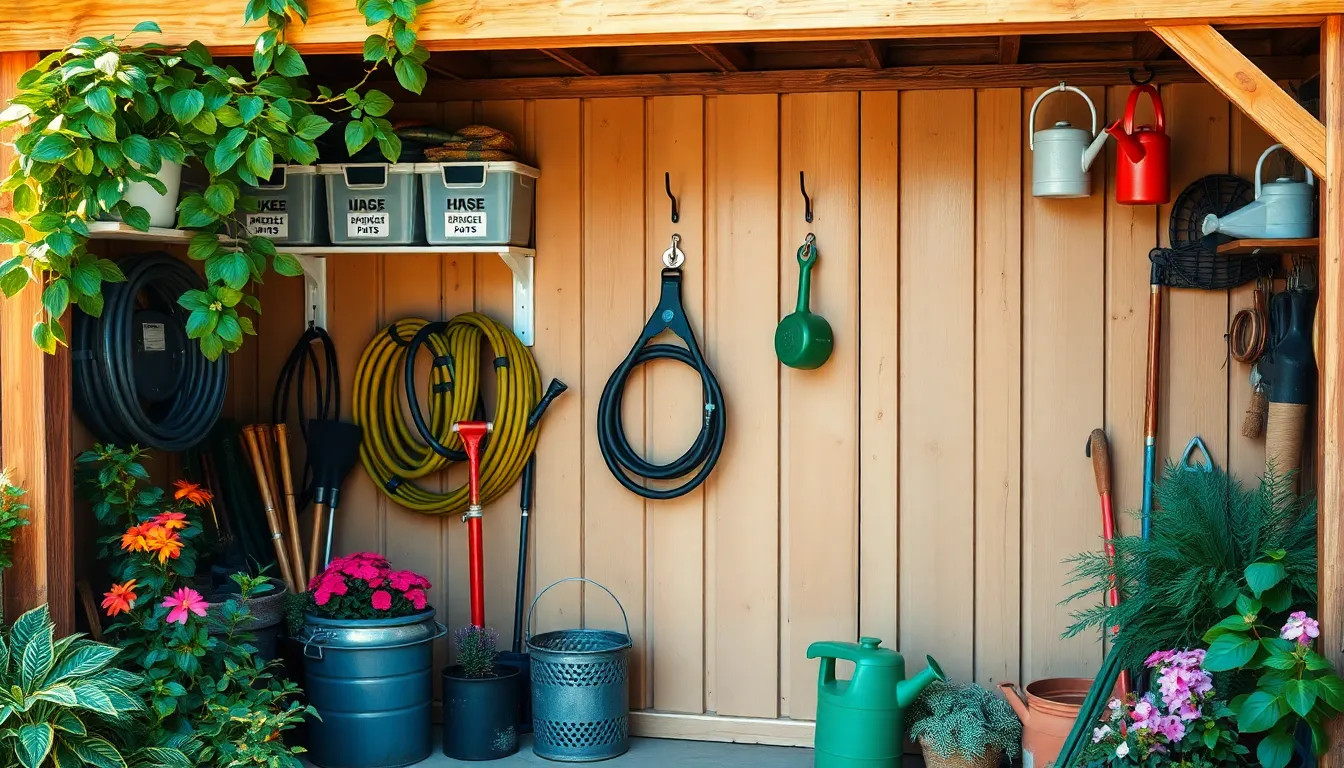
Effective irrigation systems form the backbone of successful garden management and require strategic organization to function optimally. Smart storage answers keep watering equipment accessible while protecting valuable irrigation components from weather damage.
Install Hose Storage Answers
Install hose reels or storage boxes to transform tangled hose chaos into organized watering stations. Wall-mounted hose reels near water sources eliminate the frustration of dragging heavy hoses across garden beds while preventing damage from ground exposure.
Position storage boxes strategically around larger garden areas to reduce the distance we need to carry hoses for different watering zones. These weatherproof containers protect rubber components from UV damage and extend hose lifespan significantly.
Choose retractable hose systems for smaller gardens where space efficiency matters most. These compact answers mount directly to exterior walls and automatically coil hoses after each use.
Create Watering Can Stations
Designate exact areas for watering cans by installing wall hooks or dedicated shelving near water sources for quick filling and emptying. Multiple watering stations throughout larger properties reduce carrying distances and improve watering efficiency.
Hang watering cans from potting bench hooks to keep them clean and prevent rust from ground contact. This placement ensures cans stay dry between uses while remaining easily accessible during daily garden rounds.
Establish can cleaning areas with nearby hoses or water access to rinse fertilizer residue and prevent chemical buildup. Clean watering equipment delivers better results and lasts longer than neglected tools.
Organize Sprinkler and Irrigation Supplies
Store sprinkler parts in labeled bins organized by component type such as heads, connectors, and repair pieces. Clear storage containers allow quick identification of needed parts during maintenance or system upgrades.
Maintain irrigation supply inventories in dedicated tool shed sections with repair kits, replacement components, and seasonal attachments clearly separated. This organization prevents costly delays when irrigation problems arise during peak growing seasons.
Group related equipment together including timers, pressure gauges, and installation tools in portable toolboxes for efficient system maintenance. Mobile organization systems allow us to bring necessary supplies directly to repair locations rather than making multiple trips to storage areas.
Build Vertical Storage Solutions
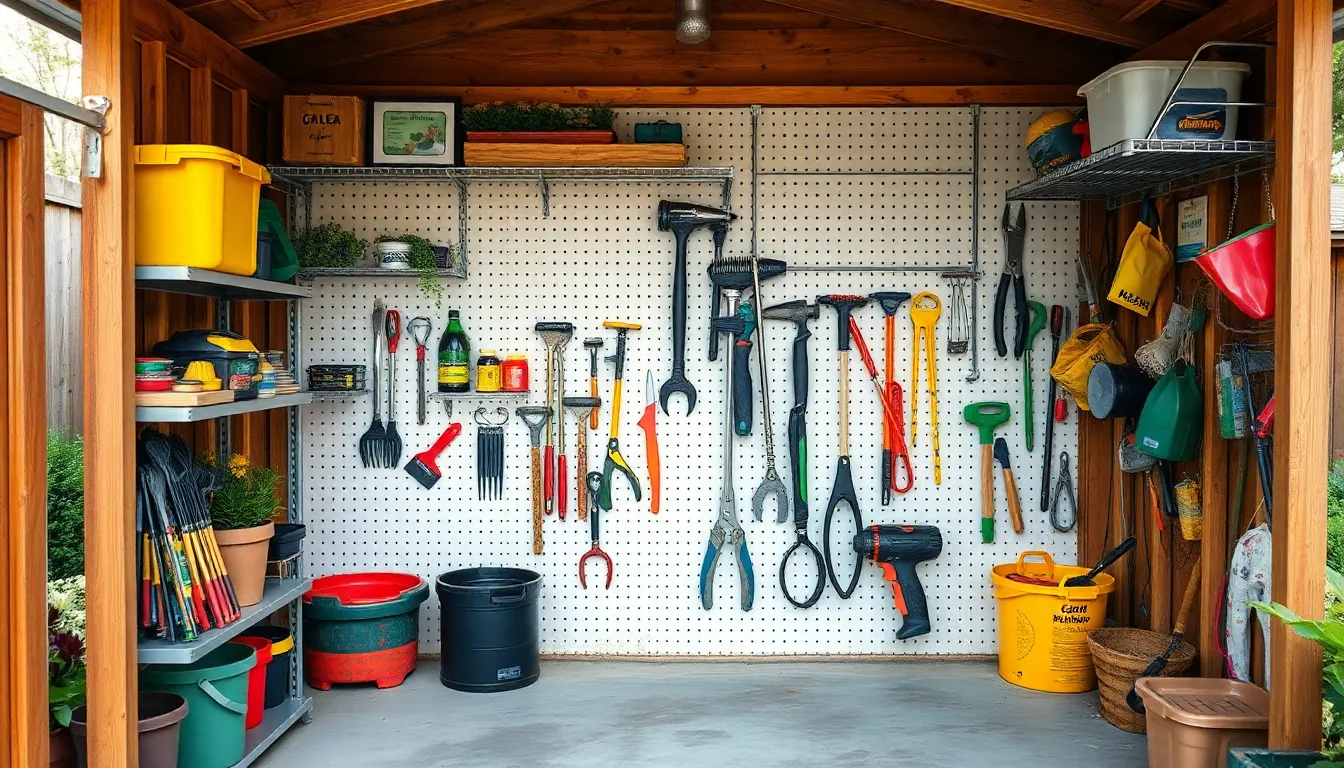
Vertical storage transforms our garden spaces by maximizing every inch of available area. Smart vertical answers help us organize tools and supplies while keeping our garden workspace clutter-free.
Install Garden Shed Organization Systems
Adjustable shelving systems revolutionize how we store our gardening equipment and supplies. These flexible storage units accommodate different sizes of items from lawn care equipment to smaller gardening accessories. We can easily reconfigure the shelf heights as our storage needs change throughout the seasons.
Free-standing metal shelving units provide durable storage options for bins and storage containers. Metal shelves resist weather damage and can be repositioned anywhere in our shed or garden area. We’ll find these shelving systems perfect for organizing heavy items like soil bags and fertilizer containers.
Incorporating vertical storage sheds made from resin materials offers an elegant solution for tool organization. Resin sheds mimic the appearance of more expensive materials while providing weather resistance and durability. These vertical structures fit perfectly in smaller garden spaces where traditional horizontal sheds won’t work.
Use Pegboard Storage Walls
Pegboard tool organizers maximize our wall space while keeping frequently used tools within easy reach. We can hang everything from pruning shears to small hand tools on these versatile storage walls. The pegboard system allows us to customize our tool arrangement based on how often we use exact items.
Wall-mounted pegboards create instant organization in sheds and garden storage areas. We can add hooks, baskets, and specialized holders to accommodate tools of various shapes and sizes. This system keeps our tools visible and prevents the frustration of searching through cluttered drawers or bins.
Floating shelves complement our pegboard systems by providing additional storage for planters and cleaning supplies. These shelves use wall space that might otherwise go unused. We can install multiple shelf levels to create comprehensive storage answers for all our gardening essentials.
Create Overhead Storage Racks
Overhead storage racks use the often-forgotten ceiling space in our sheds and garden areas. We can store seasonal items and less frequently used tools on these elevated platforms. This approach keeps our floor space clear for daily gardening activities and equipment.
Design overhead racks specifically for items we don’t access regularly, such as holiday decorations or specialized gardening equipment. These storage answers work particularly well for lightweight but bulky items that take up valuable floor space. We should ensure our overhead systems can safely support the weight of stored materials.
Strategic placement of overhead storage creates multiple storage zones within our garden workspace. We can designate different overhead areas for exact categories of items, making retrieval easier when needed. This systematic approach to vertical storage helps us maintain an organized and efficient garden environment.
Organize Garden Supplies by Season
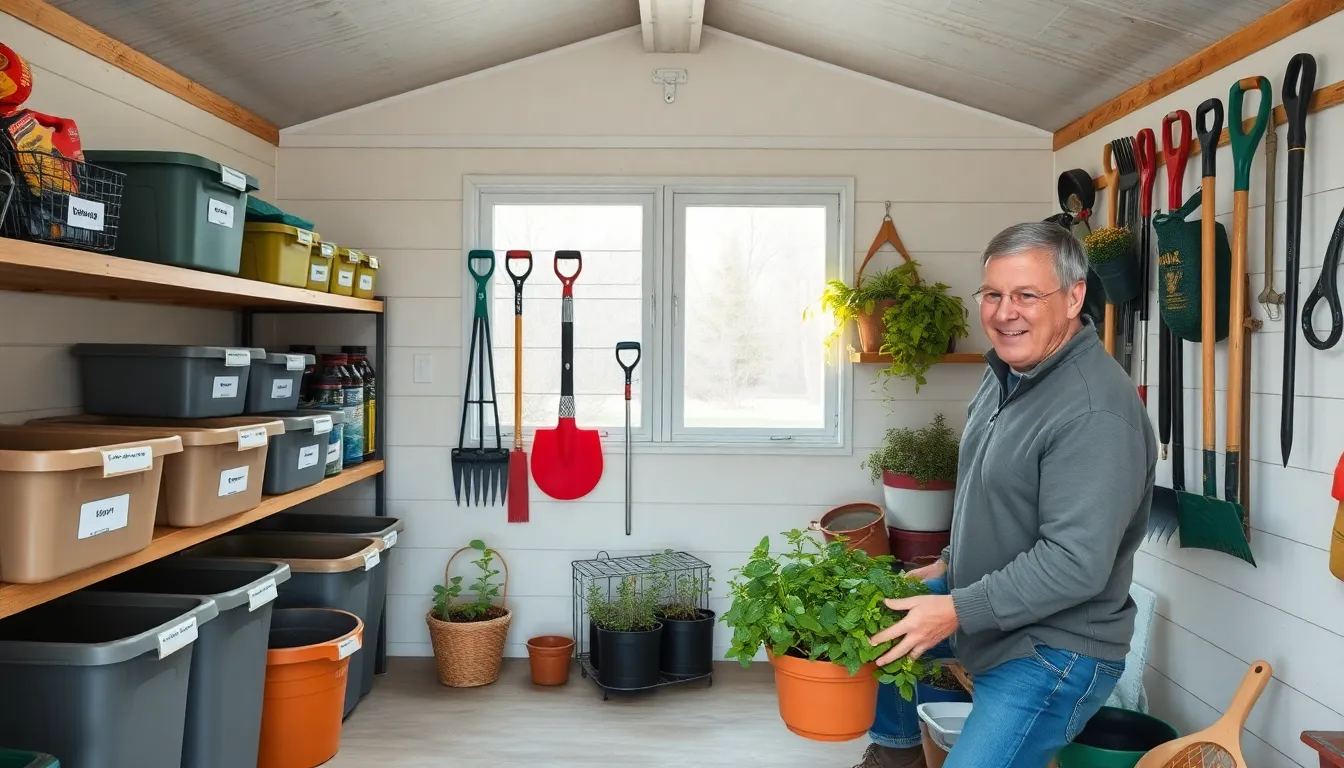
Seasonal garden organization transforms chaotic storage spaces into efficient systems that support year-round gardening success. We’ll examine three critical seasonal organization strategies that maximize storage space and keep essential supplies accessible when needed.
Store Winter Garden Equipment
Clearing your storage area before winter arrives eliminates unnecessary clutter and creates designated spaces for essential equipment. We recommend removing broken tools, expired chemicals, and items that haven’t been used in the past two seasons to maximize available storage space.
Protecting sensitive equipment from harsh winter conditions preserves tool longevity and prevents costly replacements. Store power tools, hoses, and metal implements in dry, temperature-controlled areas like garages or weatherproof storage boxes to prevent rust and freeze damage.
Labeling stored winter equipment ensures quick identification when spring gardening season begins. Use waterproof labels on storage bins and containers to clearly mark contents, including snow shovels, ice melt, plant covers, and winterization supplies for easy retrieval.
Organize Spring Planting Supplies
Sorting and purging gardening supplies at winter’s end eliminates expired seeds, damaged tools, and unnecessary items that consume valuable storage space. We suggest checking seed packets for expiration dates and testing older seeds for viability before discarding them.
Designating exact storage zones for spring planting materials creates an efficient workspace that streamlines preparation activities. Establish separate areas for seed starting supplies, transplanting tools, and soil amendments within easy reach of your primary work area.
Using labeled storage bins for smaller spring items like seeds, plant markers, and fertilizers prevents misplacement during busy planting seasons. Clear plastic containers work exceptionally well because they allow visual inventory checks without opening each container.
Maintain Summer Garden Tools
Hanging frequently used tools on wall-mounted organizers keeps them visible and easily accessible during peak gardening season. Install hooks, pegboards, or magnetic strips near garden entrances to eliminate time spent searching for essential tools like pruners, trowels, and watering equipment.
Cleaning and maintaining tools regularly throughout summer prevents rust buildup and extends tool life significantly. We recommend wiping tools clean after each use and applying light oil to metal surfaces weekly during heavy use periods.
Storing daily-use tools in portable caddies or rolling carts allows us to transport everything needed directly to work areas. Position these mobile storage answers in central garden locations to minimize trips back to main storage areas during intensive gardening sessions.
Create Harvest and Produce Organization Areas
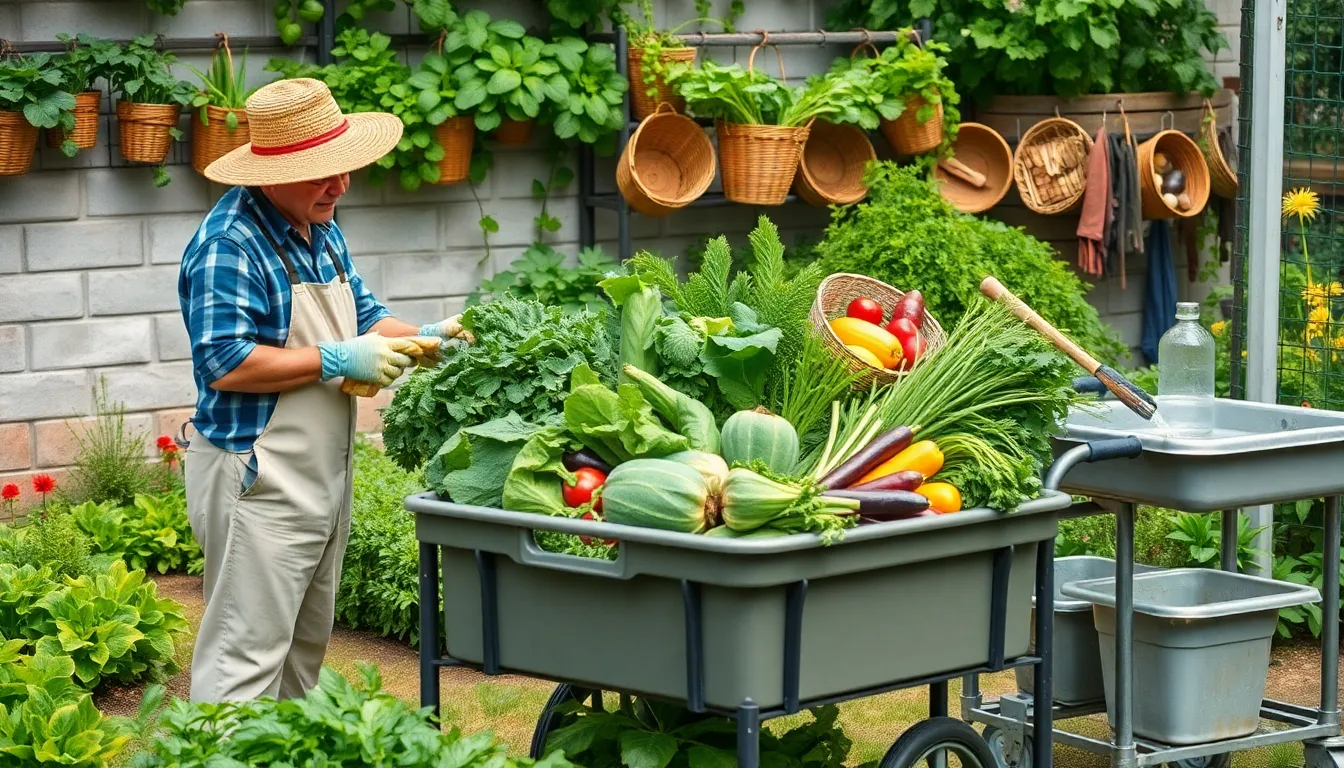
We need efficient harvest organization systems to transform our gardening success into streamlined produce management. Designating distinct zones for harvesting and organizing produce creates the foundation for smooth workflow from garden to kitchen.
Set Up Harvest Basket Storage
Wall-mounted racks become essential storage answers that keep our harvest baskets dry and easily accessible. Installing hooks or shelving systems prevents baskets from sitting on damp ground where they might develop mold or deteriorate quickly. We recommend positioning these storage areas within three feet of main garden pathways to ensure effortless access during busy harvest periods.
Mobile storage answers offer flexibility when we’re dealing with peak harvest times and need baskets in multiple garden zones. Rolling carts equipped with basket holders can move directly to harvesting areas, reducing the number of trips we make back to static storage locations. Labeling each storage spot for exact basket types—such as “leafy greens” or “root vegetables”—streamlines our workflow and prevents cross-contamination between different produce categories.
Organize Processing and Preservation Tools
Centralizing our processing tools in a designated shed or garden area creates an efficient workspace for post-harvest activities. Pegboards and hooks provide immediate visibility for frequently used items like knives, cutting boards, and canning equipment, ensuring we can grab what we need without searching through drawers or bins. We should position this processing zone within easy reach of our harvest areas to minimize the distance fresh produce travels.
Clearly labeled bins or cabinets house our preservation supplies including jars, lids, and labels in an organized system. Dedicating a exact shelf or countertop for active use keeps tools clean and ready immediately after harvest. We can maximize our efficiency by grouping similar items together—all canning supplies in one area, dehydrating equipment in another, and fresh storage containers in a third zone.
Create Produce Washing Stations
Installing a washing station with a sturdy table and basin transforms our post-harvest process into a streamlined operation. Portable stations work well for smaller gardens, while permanent installations suit larger operations that process important volumes of produce regularly. We should position these stations as close as possible to harvest areas to reduce handling time and prevent produce damage during transport.
Sloped surfaces or built-in colanders help water drain efficiently, preventing pooling that could damage delicate produce. Including storage space beneath the station for brushes, towels, and cleaning supplies keeps everything within arm’s reach during washing activities. We can enhance functionality by ensuring our washing station has adequate lighting and is positioned at a comfortable working height to prevent back strain during extended processing sessions.
Design Compost and Waste Management Systems
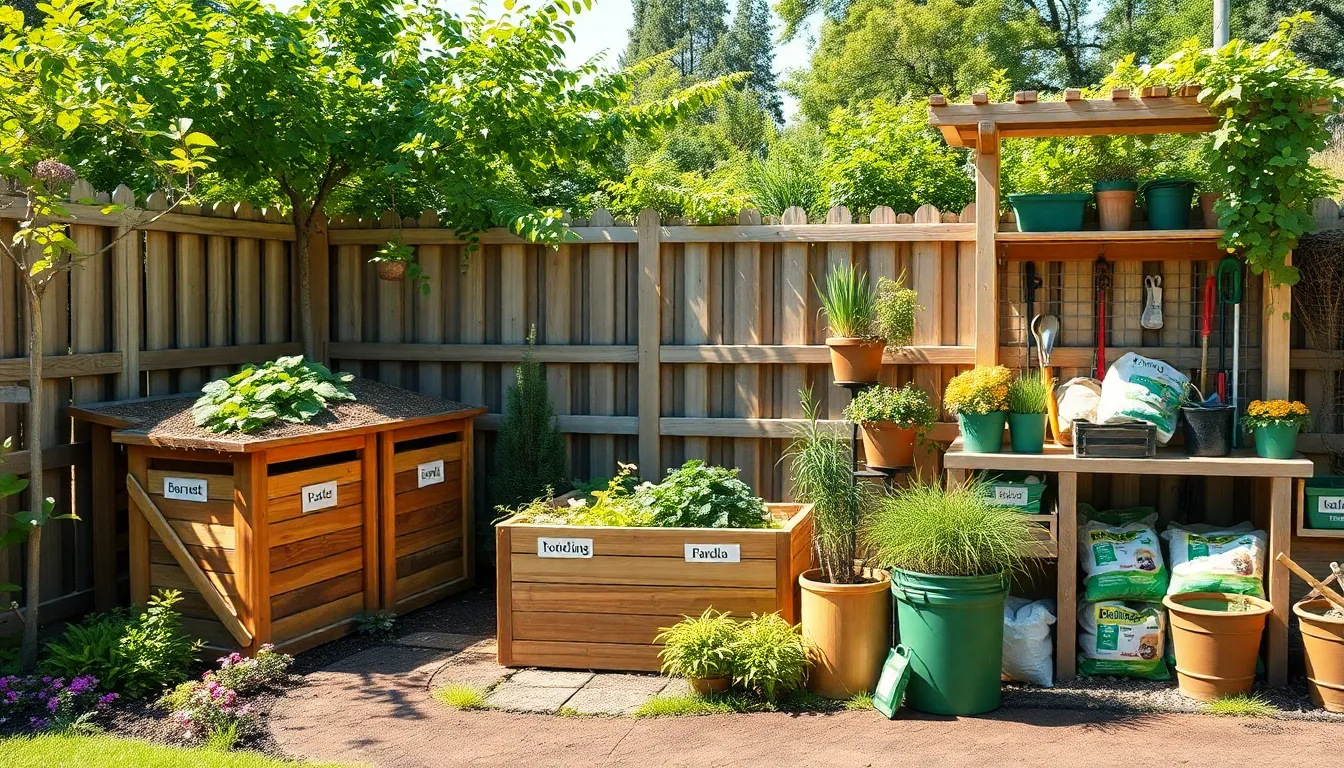
Effective waste management transforms your garden into a sustainable, productive space while reducing environmental impact. We’ll create systematic approaches that handle organic matter, recyclables, and garden debris efficiently.
Establish Organized Compost Areas
Set aside a dedicated compost area that’s accessible but positioned away from main garden activities. We recommend placing your compost site near the garden but directly on soil to allow proper drainage and beneficial organism access.
Create clearly defined compost zones separate from other garden areas to prevent contamination and maintain organization. Raised compost bins or containers help turning and aeration while keeping materials contained and tidy.
Consider a three-bin system for staged composting that allows continuous waste processing. Cover compost bins to maintain optimal moisture and temperature levels throughout the decomposition process.
Position your compost area where it receives partial sunlight and remains easily accessible for regular maintenance. We suggest locating it within 50 feet of your main garden beds for convenient material transport.
Create Garden Waste Collection Points
Establish distinct collection points for garden waste such as pruned branches, leaves, and spent plants near high-activity areas. Place these stations beside garden beds and pathways where waste generation occurs most frequently.
Use clearly marked bins, bags, or open piles to separate different types of organic matter for efficient processing. Label containers by waste type to streamline sorting and prevent contamination between materials.
Mount weatherproof containers like metal lidded mailboxes beside garden beds to hold small everyday tools and organize garden waste collection. These dual-purpose stations keep your workspace tidy while providing immediate access to essential implements.
Position collection points strategically throughout your garden to minimize carrying distances during cleanup activities. We recommend placing one collection station for every 100 square feet of active gardening space.
Organize Recycling and Disposal Systems
Set up designated containers for recyclable garden materials including plastic plant pots, seed trays, and packaging near your garden shed or potting bench. Group these materials for easy sorting during regular garden maintenance sessions.
Install a potting station with integrated storage to keep soil bags, tools, and recyclable materials organized in one central location. Choose benches with storage below that serve dual purposes for both work activities and waste sorting.
Create sorting systems that separate compostable materials from recyclables and non-compostable wastes to prevent garden pollution. Use labeled bins or sections to maintain clear distinctions between different waste categories.
Schedule regular removal of non-compostable wastes and plastics to avoid clutter accumulation in your garden space. We suggest weekly disposal runs during peak growing season and monthly removal during dormant periods.
Implement Garden Planning and Record Keeping
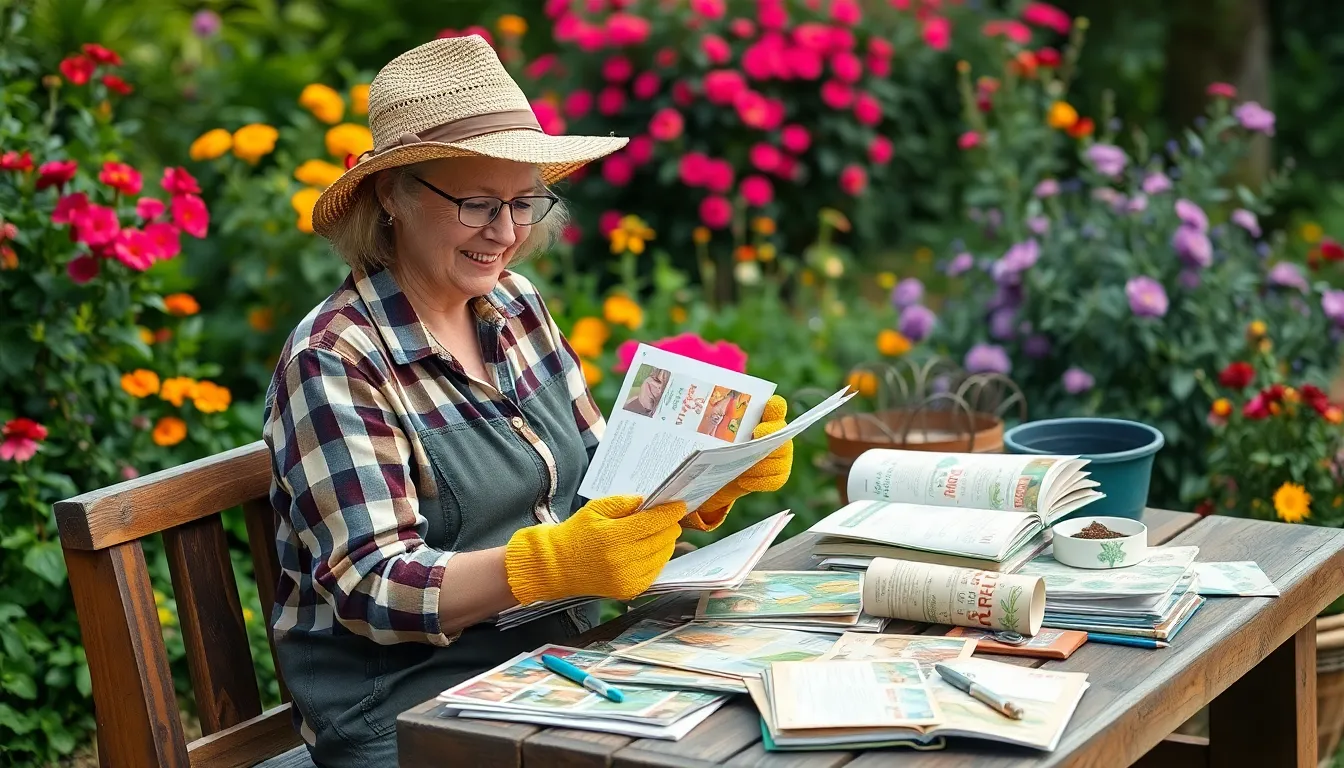
Strategic documentation transforms our gardening approach from reactive to proactive. Thorough record keeping helps us learn from past seasons and dramatically improves future garden outcomes.
Create Garden Journal Storage
Establish a dedicated storage system for our garden journals using a consistent notebook or binder approach. We recommend maintaining all records together in one accessible location to prevent lost documentation and scattered notes.
Carry out a Traveler’s Notebook system to hold multiple six-month journals throughout the year. This approach keeps our entire year’s worth of garden observations, planting schedules, and growth progress in one convenient place.
Position journal storage near our main gardening workspace or potting area for quick access during active gardening sessions. We should choose weather-resistant storage answers if keeping journals in outdoor spaces like garden sheds or greenhouses.
Create backup systems by photographing or scanning important journal pages to prevent total loss of valuable gardening data. Digital backups ensure we can reference critical information even if physical journals become damaged or misplaced.
Organize Planning Materials and Calendars
Designate a central planning hub using folders, binders, or digital apps to consolidate seed catalogs, plant tags, calendars, and seasonal reminders. We need quick access to these materials when making planting decisions or scheduling garden maintenance tasks.
Use calendar-style almanacs or daily planners specifically for tracking garden activities and maintenance reminders. These tools ensure we complete seasonal tasks like seed starting, fertilizing, and harvest timing at optimal moments.
Sort planning materials by season or plant category to streamline our decision-making process. We can create separate sections for spring planting schedules, summer maintenance tasks, fall cleanup activities, and winter preparation requirements.
Maintain expense tracking within our planning system to monitor seed purchases, tool investments, and garden improvements. This financial documentation helps us budget effectively and evaluate which gardening investments provide the best returns.
Store Reference Books and Guides
Create a dedicated reference library on shelves or in cabinets near our planning area for quick consultation during garden decision-making. We should organize these resources by topic, such as plant identification, pest management, soil improvement, and garden design principles.
Position frequently used guides at eye level for immediate access during urgent gardening situations. Plant identification books, pest troubleshooting manuals, and local growing guides deserve prime placement in our reference system.
Protect valuable references from moisture and temperature fluctuations using closed storage answers or climate-controlled spaces. We can use plastic storage bins or glass-front cabinets to shield books from garden-related humidity and dirt.
Organize digital resources alongside physical books by bookmarking reliable gardening websites and apps on our devices. This hybrid approach ensures we have comprehensive information available whether we’re working indoors at our planning station or actively gardening outdoors.
Conclusion
We’ve explored comprehensive strategies that transform chaotic outdoor spaces into efficient productive environments. From dedicated tool zones and vertical storage answers to seasonal organization systems and harvest management these approaches work together to create gardens that thrive year-round.
The key to successful garden organization lies in creating systems that match your exact needs and space constraints. Whether you’re working with a small urban plot or expansive acreage these principles scale to fit any gardening situation.
Start with one area that causes you the most frustration and build from there. We’ve found that tackling organization gradually leads to lasting results and prevents overwhelm during the implementation process.
Remember that organized gardens aren’t just more beautiful—they’re more productive efficient and enjoyable to maintain. Your future self will thank you for the time invested in creating these foundational systems.
Frequently Asked Questions
What are the main benefits of organizing my garden?
Garden organization enhances both aesthetic appeal and efficiency, saving you time while maximizing your garden’s potential. An organized garden makes tools easily accessible, improves plant health through proper spacing and grouping, and creates a more enjoyable gardening experience. It also helps you maintain better records and make informed decisions about your garden’s future.
How do I create an effective tool storage system?
Establish a central tool station near your garden’s main entrance using a sturdy workbench or repurposed table. Install wall-mounted racks for long-handled tools, group similar tools together, and consider rolling cart systems to transport tools directly to work areas. This reduces trips back to storage and keeps tools organized and accessible.
What should I include in a functional potting area?
Create a potting bench with built-in storage, tool hooks, and access to a nearby water source. Organize potting supplies in labeled containers to prevent mix-ups, and maximize vertical space with shelving systems. Consider mobile workstations like rolling carts tailored for specific potting tasks to streamline your workflow.
How can I organize my seeds and plants effectively?
Use clear storage containers for seeds to improve visibility and monitor seed conditions. Create systematic plant labeling to eliminate confusion, and group plants by their growth requirements (sunlight, water, soil preferences). This strategic organization simplifies maintenance, aids in planning garden activities, and promotes healthier plant growth throughout the season.
What’s the best way to organize my watering systems?
Install hose storage solutions like wall-mounted reels or weatherproof storage boxes. For smaller gardens, use retractable hose systems for space efficiency. Create designated watering can stations and organize sprinkler supplies in labeled bins. This enhances watering efficiency and ensures your irrigation systems function optimally.
How do I maximize storage space in my garden shed?
Utilize vertical storage solutions including adjustable shelving systems, wall-mounted pegboards, and overhead storage racks. Use resin vertical storage sheds for smaller spaces, install floating shelves for additional storage, and organize supplies in clearly labeled containers. This maximizes available space while keeping work areas clutter-free.
How should I organize my garden for different seasons?
Store winter equipment by clearing clutter and protecting tools from harsh conditions. Organize spring planting supplies in designated zones with labeled bins. Maintain summer tools by keeping them visible and clean. Create seasonal rotation systems to ensure essential supplies are accessible when needed throughout the year.
What’s the best way to organize harvest and produce management?
Create distinct harvesting zones with wall-mounted racks for basket storage. Use mobile storage solutions like rolling carts during peak harvest times. Organize processing tools on pegboards in a designated area, establish produce washing stations near harvest areas, and label all storage spots to prevent cross-contamination.
How do I set up an effective compost and waste management system?
Establish organized compost areas away from main garden activities using raised bins for proper aeration. Implement a three-bin system for staged composting and create clearly marked waste collection points for efficient sorting. Designate separate containers for recyclable materials and ensure regular removal of non-compostable waste.
Why is garden record-keeping important and how do I organize it?
Garden record-keeping helps track what works, plan future seasons, and monitor expenses. Create a dedicated storage system for garden journals near your main workspace, organize planning materials in a central hub, and maintain both physical and digital backups. Include seed catalogs, plant tags, and seasonal reminders for comprehensive planning.

